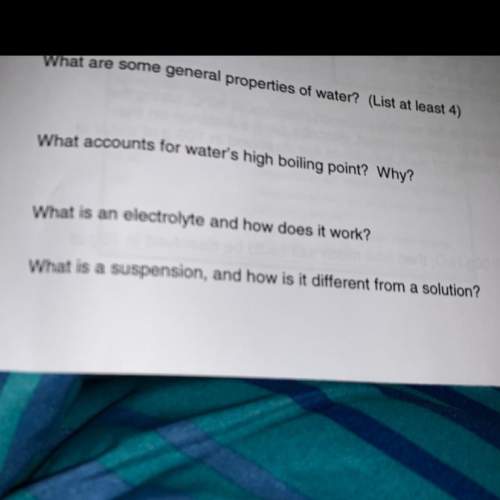
Chemistry, 31.08.2021 19:50 jaquiel9358
Prior info Flask mass = 31.601 g Water + flask mass = 60.735 g Water density = 0.9973 g/cm^3 Mass of water = (water + flask mass) - (flask mass) = 60.735 - 31.601 Mass of water = 29.134g Volume of water = mass of water/density of water = 29.134 g/0.9973 g/cm^3 = 29.2139 cm^3 Volume of flaskLiquid + flask mass = 56.796 g Mass of liquid = (Liquid + flask mass) - (flask mass) = 56.796 - 31.601 = 25.195 g Density of liquid = Mass of liquid/Volume of flask = 25.195 g/29.2139 cm^3 = 0.8624 g/cm^3
Finding the density of a solid. The student then emptied the flask and dried it once again. To the empty flask she added pieces of metal until the flask was about half full. She weighed the stoppered flask and its metal contents and found that the mass was 99.323 g. She then filled the flask with water, stoppered it, and obtained a total mass of 120.827 g for the flask, stopper, metal, and water. Find the density of the metal. a. To find the density of the metal we need to know its mass and volume. We can easily obtain is mass by the method of differences:
(Mass of metal) = g - g = g b. To determine the volume of metal, we note that the volume of the flask must equal the volume of the metal plus the volume of water in the filled flask containing both metal and water. If we can find the volume of water, we can obtain the volume of metal by the method of differences. To obtain the volume of the water we first calculate its mass:
Mass of water = mass of (flask + stopper + metal + water) – mass of (flask + stopper + metal) Mass of water = g - g = g The volume of water is found from its density, as in 1b. Make the calculation. Volume of water = cm3 c. From the volume of the water we calculate the volume of metal:
Volume of metal = volume of flask – volume of water
Volume of metal = cm3 - cm3 =
cm3
From the mass and volume of the metal we find the density, using the equation in 1b. Make the calculation.
Density of metal = g/cm3 Now go back to Question 1 and check to see that you have reported the proper number of significant figures in each of the results you calculated in this assignment. Use the rules on significant figures as given in your chemistry text.
experimental-chemistry

Answers: 3
Another question on Chemistry

Chemistry, 22.06.2019 09:00
Look at the spectrums of a star moving towards earth and a motionless star. which of these is a correct inference that can be draw from the observation of the two spectrums? (2 points) the spectrum of a motionless star is difficult to be viewed separately using oridinary telescopes. the spectrum of a motionless star is identical to the spectrum of a star which moves towards earth. the spectrum of a star shifts towards the red region when the star moves towards earth. the spectrum of a star shifts towards the blue region when the star moves towards earth.
Answers: 2

Chemistry, 22.06.2019 15:00
According to the diagram, what sources contribute to the phosphorus found in soil? according to the diagram, phosphorus found in soil contributes phosphorus to what other sources?
Answers: 1

Chemistry, 22.06.2019 15:20
Water is initially present in a state where its molecules are far apart. during a change of state, its molecules slow down. which change of state has most likely taken place? from a gas to a liquid from a liquid to a gas from a solid to a liquid from a gas to a plasma
Answers: 1

Chemistry, 22.06.2019 15:20
Which description best characterizes the motion of particles in a solid?
Answers: 2
You know the right answer?
Prior info Flask mass = 31.601 g Water + flask mass = 60.735 g Water density = 0.9973 g/cm^3 Mass of...
Questions

Mathematics, 24.04.2020 22:56

Spanish, 24.04.2020 22:56


Mathematics, 24.04.2020 22:56





Mathematics, 24.04.2020 22:56

Physics, 24.04.2020 22:56

Mathematics, 24.04.2020 22:56


Engineering, 24.04.2020 22:56

Social Studies, 24.04.2020 22:56

Mathematics, 24.04.2020 22:56


Mathematics, 24.04.2020 22:56

Mathematics, 24.04.2020 22:56

Social Studies, 24.04.2020 22:56




